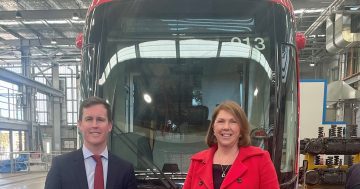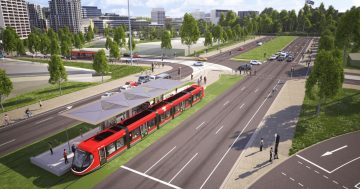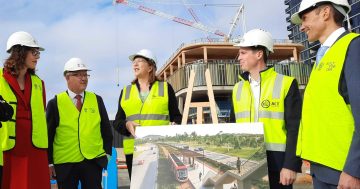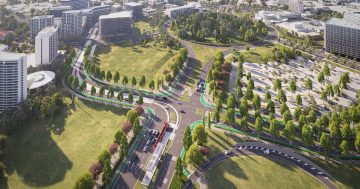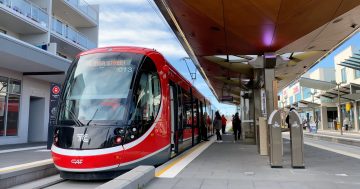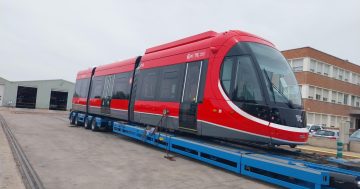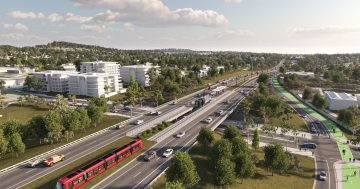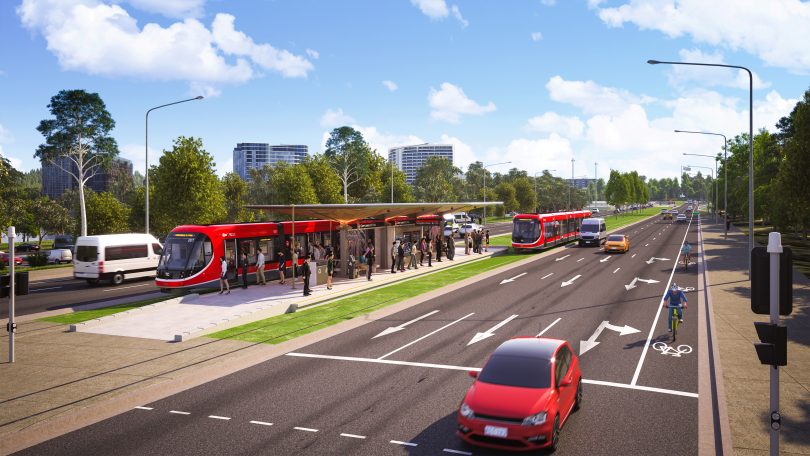
The proposed Commonwealth Park stop for Stage 2A. Construction is still due to start next year. Image: Supplied.
Plans for the extension of light rail to Woden should be accelerated to boost the ACT’s coronavirus-hit economy, according to the Public Transport Association of Canberra.
As the ACT marked a year of operation for Stage 1 between Gungahlin and the city, association chair Ryan Hemsley says the government and the National Capital Authority should seize the opportunity presented by the economic shutdown to bring the project forward.
Despite patronage falling off a cliff due to the COVID-19 stay-at-home measures, Mr Hemsley said Stage 1 had exceeded all expectations and pointed to the prospects of further stages such as City to Woden.
“This project has proven that there is an untapped demand for high-quality public transport services in the ACT,” he said. ”We believe that similar patronage increases can be expected as future stages of the network are rolled out in the years ahead, providing benefits to both current and future generations of Canberrans.”
Mr Hemsley said the economic slowdown meant moving ahead on light rail to Woden had become all the more urgent.
”This project will have the double benefit of stimulating the economy in the short term, while providing improved public transport options in the medium to long term,” he said.
“It will also help the ACT meet its planned reductions in carbon emissions by being powered solely by electricity from renewable sources.”
Mr Hemsley said social distancing measures also presented an opportunity for the ACT Government and NCA to conduct important works during a period of reduced traffic, such as upgrades to London Circuit as part of Stage 2A and the modifications to Commonwealth Avenue Bridge that will future-proof it for Stage 2B.
“We call on both the ACT Government and National Capital Authority to work collaboratively so that these projects can be fast-tracked in a manner that provides the greatest long-term benefit while minimising disruption to road users in the short term.”
Master Builders ACT also has been pushing for the ACT Government to fast-track infrastructure projects, including light rail.
”Light rail is a great opportunity for local civil contractors but also all the suppliers that would service them as well,” CEO Michael Hopkins said.
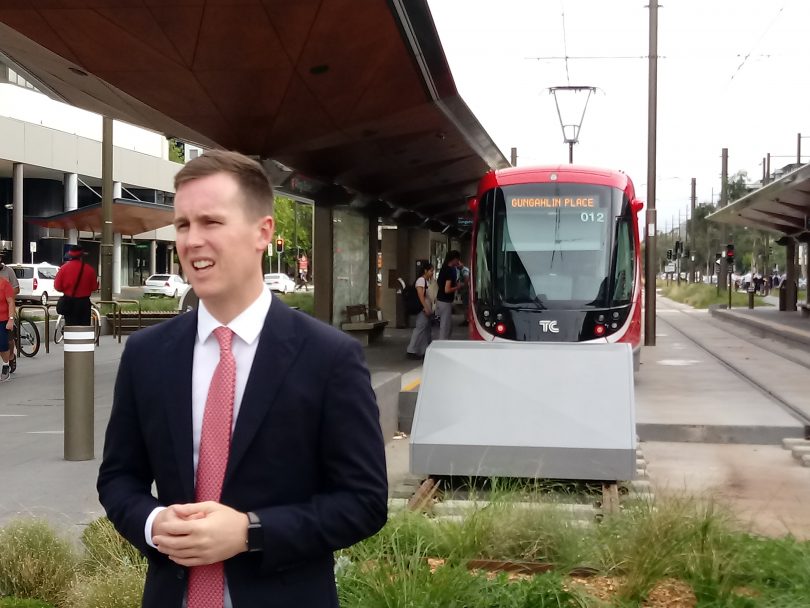
Transport Minister Chris Steel at the Alinga Street terminus, Stage 1’s most popular stop. Photo: File.
Transport Minister Chris Steel would not say if the government was actively pursuing talks with the NCA to expedite the approvals process but the Commonwealth would continue to be pressed for a funding contribution.
He said site investigations had commenced on Stage 2A, with findings to be used to inform the project’s detailed design.
Commonwealth and Territory works and planning approvals would be sought later this year and construction work was still scheduled to begin in 2021, he said.
“The ACT Government has previously sought Commonwealth Government funding commitments to the project and will continue to do so. It is a project that is of direct benefit to the Commonwealth Government,” Mr Steel said.
He said that in the first year of light rail the community had shown massive support for the project with more than 4.2 million boardings.
While the number of weekday journeys was down by 88.5 per cent in the week ending 12 April compared with the same week in 2019, Mr Steel said that before the pandemic there were, on average, 15,047 passenger boardings each day, numbers not expected until 2021.
According to the latest customer survey, 94 per cent of customers were satisfied with the ease of use of the light rail and it is now making up around 20 per cent of all public transport boardings (bus and light rail).
“Light rail hasn’t just benefited public transport users, it has reduced traffic on our roads with data showing up to a 20 per cent reduction in vehicles travelling along Northbourne Avenue during the morning peak period,” Mr Steel said.
The busiest month in the first year of operations was May during the free travel period with over 460,000 customers travelling, followed by October 2019 with over 411,000 boardings.
The most frequented light rail stop was Alinga Street in the City with nearly 40 per cent of light rail trips commencing at that station.
“We are committed to building on this success and extending the benefits of light rail to Woden which will create a north-south spine for the network,” Mr Steel said.












